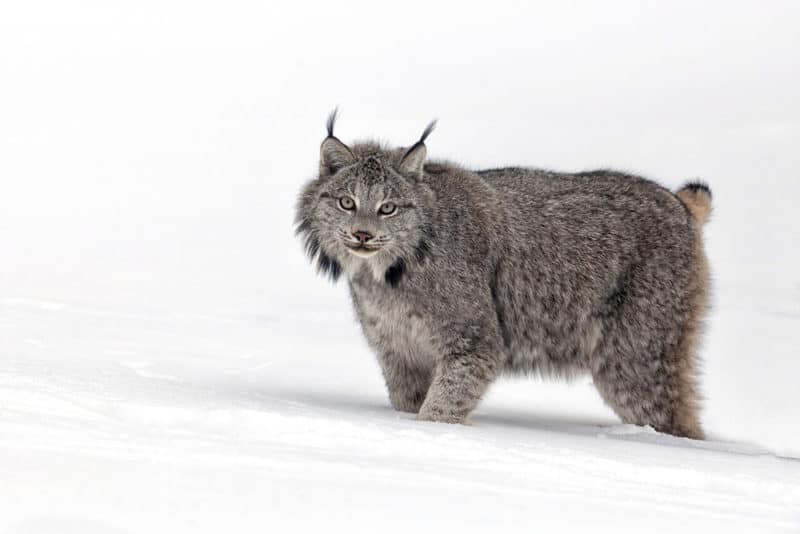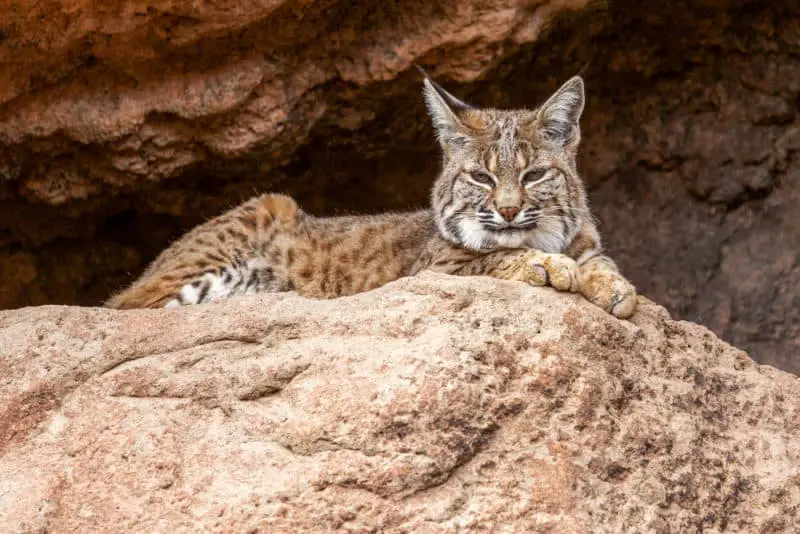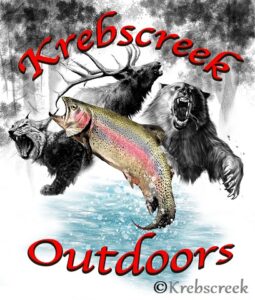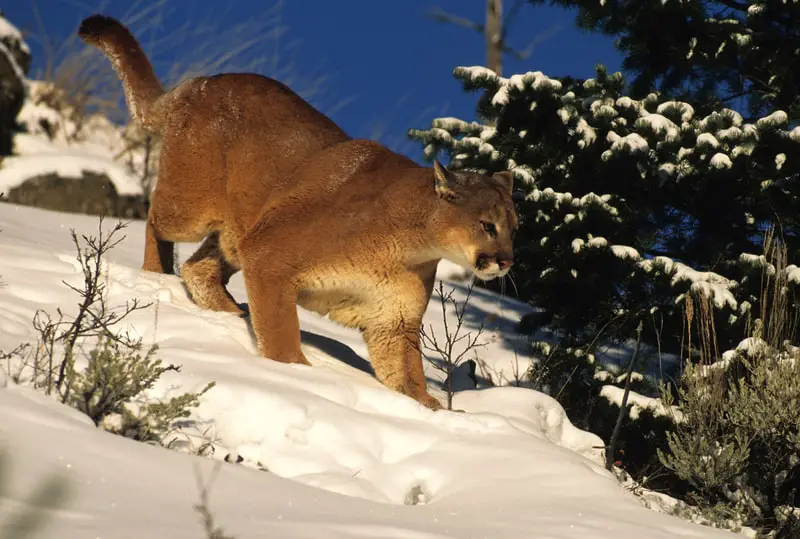Washington State is home to 3 species of wild cats. They are, namely, the mountain lion, the Canadian lynx, and the bobcat.
Mountain lions in Washington (Puma concolor)
Due to the fact that they live over a wide geographical area, mountain lions have a long list of regional names. In recent years, their scientific name was even changed from Felis concolor to Puma concolor. Some common names that mountain lions go by are cougar, panther painter, Andean Mountain lion, and puma.
In Washington, the mountain lion is an apex predator. So are the state’s black bears and grizzly bears.
The mountain lion population in the state of Washington currently sits at around 1,500 of the large cats.
Mountain Lion Hunting in Washington
The state of Washington classifies mountain lions as game animals. A valid hunting license is required to hunt them. There are 2 cougar seasons in the state. The early season lasts from September 1 to December 31, while the late season lasts from January 1 to April 30 or when the harvest guideline is reached, whichever occurs first.
What do Mountain Lions Look Like?
To visualize what a mountain lion looks like, picture a giant house cat with short tan hair. Mountain lions are much larger than domestic cats, though. An average house cat weighs around 10 pounds, while male mountain lions can weigh over 200 pounds.
These animals, in general, have lean, muscular bodies, rounded heads, and upright ears that are oval at the tip. Another characteristic of the mountain lion is its long, black-tipped tail, which accounts for almost one-third of its entire length. Their long tail helps to them keep balanced as they navigate through uneven terrain.
Mountain lions have a light brown coat of short, coarse hair over most of their body. The area around their nose, the tip of their tail, and the tips of their ears are black. Their belly, the area above their upper lip, below their lower lip, and their chin are all white. They also have a sprinkling of dark hair on their backs. Bear in mind, though, that their coat color varies somewhat with geographic location.
Mountain lions are the fourth largest wildcat in the world. They are smaller in size only than the Jaguar in the Americas. However, worldwide, the African Lion and the Tiger are also larger.
Male and female mountain lions are phenotypically identical in every respect except for size. Males are 30 to 40% bigger than females. Though sizes vary considerably throughout the cat’s geographic range, an adult male typically weighs between 110 and 180 pounds, 50 to (82 kgs). A rare few of them grow bigger than 200 pounds (91kgs). Female mountain lions or queens average between 80 and 130 pounds (36 to 59 kgs). Adult males or toms will reach a length of 6 to 8 feet (1.8 to 2.4 M) from their snout to the tip of their tail. On the other hand, adult females are 5 to7 feet long (1.5 to 2.1 M).
A fun fact is that despite their large size, they are not taxonomically classified as big cats because they cannot roar. Leopards, for example, are smaller than mountain lions, but since they can roar and cannot purr, they are classified as big cats while mountain lions are not. Another interesting thing that I can mention here is that mountain lions purr.
Since they purr and cannot roar, mountain lions are in the Felis genus, while big cats that cannot purr and can roar are in the Panthera genus.
Mountain Lion Behavior
Mountain lions are solitary animals. It’s a Rarity to see 2 or more together unless during the time that they come together to mate or in the case of raising young.
They have expansive home territories. In fact, an adult male mountain lion’s home range is normally more than 100 square miles and up to 250 square miles. They will sometimes mark their territory by leaving claw marks on trees. They also scratch up piles of leaves and or pine needles that they urinate on as a scent marker. Male mountain lions fight to the death sometimes to defend their territory.
A mountain lion is a formidably tough wild animal. They can run 40 to 50 miles per hour for short bursts and jump up to 40 feet with a running start. They can also leap 15 feet vertically from a flat-footed start. See
Where are Mountain Lions Typically Found?
Mountain lions live on all three of the American continents. Their range begins in Canada’s Yukon territory and extends south through parts of North America, Central America, and South America to the southern tip of Argentina.
As of the year 2017, mountain lions are taxonomically divided into 2 sub-species. The first is (Puma concolor couguar) or northern cougar. Northern cougars range through North America, Central America, and possibly northwestern South America. The second sub-species is (Puma concolor concolor) or southern cougar. These cats range only in South America.
In Canada, the biggest populations of them are in British Columbia and Alberta. On the other hand, in the United States, they mainly live in the western states and Florida. The people of Florida call this elusive cat the Florida Panther.
According to the Washington Department of Fish and Wildlife, Cougars occur throughout Washington anywhere that suitable cover and prey are found.
These big felids are primarily either nocturnal or crepuscular. However, if you’re hiking the trails of Olympic National Park on the Olympic Peninsula, you will have an ever so slightly better chance of spying one during the daylight hours. This is due to the fact that in areas where hunting is prohibited, they lose some of their natural caution.
If you should ever come upon a cougar in the wild, do not try to approach it under any circumstance. They are dangerous wild animals. Although mountain lion attacks on humans are very rare, they do occur.
See Are Mountain Lions Dangerous? – Krebs Creek to see what to do in the event that you are either stalked or attacked by a mountain lion.
What do Mountain Lions Eat?
Mountain lions mainly prey on deer. In fact, on average, an adult mountain lion kills a deer once a week. They also prey on other animals.
In Washington, mountain lions prey on Columbian black-tailed deer, Columbian white-tailed deer, white-tailed deer, mule deer, elk, moose, bighorn sheep, mountain goats, pronghorns, feral horses, coyotes, raccoons, birds, rats, feral pigs, porcupines, skunks, snakes, pets, livestock, and literally any other native wildlife they can catch.

Canada lynx in Washington (lynx canadensis)
The Canada Lynx is sometimes also known as the Canadian Lynx. They are medium-sized wild cats that live in the boreal forest in the mountainous regions of Canada and the northern United States. They are 1 of 2 North American members of the “Lynx” genus. The other one is the bobcat.
According to the Washington Department of Fish and Wildlife, lynx historically ranged through all the northern counties of Washington. However, today their range is restricted to a small portion of its original size and is almost entirely in western Okanogan County. Today Washington state’s Canada lynx population numbers less than 50. Furthermore, WDFW officials consider small population and habitat loss, and fragmentation due to large wildfires to be a couple of the chief threats facing Canada lynx within the state.
The U.S Fish and Wildlife Service listed Canada lynx in the contiguous United States as threatened under the Endangered Species Act.
Canadian Lynx Characteristics
What does a Canadian lynx look like? Canadian Lynx closely resemble their close relative, the bobcat but with some differences. First of all, they are slightly larger than bobcats. They are up to 35 1/2 inches “90 cm” long and 26 inches, “65 cm” tall. Additionally, they weigh up to 37 and a half pounds, “17 kg.
Canadian Lynx have triangular pointed ears with black backs and long tufts of black hair on the tips. The hair tufts are much longer than a bobcat’s. They also have drooping flared facial ruff of white hair on the sides of their face beneath their chin.
Their eyes are green with round black pupils.
Lynx have long legs in proportion to their bodies, with their hind legs being slightly longer than their front ones. This gives their body a peculiar, downhill-sloped appearance.
Canadian Lynx have almost comical-looking oversized fur-covered paws. There’s a good reason for this. Their large paws function like snowshoes, allowing them to travel and hunt on top of the snow. Canadian lynx feet can keep almost twice as much weight from sinking into the snow as those of a bobcat. This is why they range over the deeper snow country of northern Canada while bobcats do not.
Canada Lynx have long thick grey fur in the winter. By summertime, they have shed their grey fur and have a thinner, shorter reddish tan hair coat instead. Their color is more uniform than that of bobcats. While bobcats have black spots and mottled coloration over their entire body, Lynx are solid tan except for some mottled darker brown spots on their legs.
What do Canada Lynx eat?
Mice squirrels, ptarmigan, grouse, ducks, deer, Dall sheep, and caribou make up a minor portion of a Canadian lynx’s diet in regions where these prey animals are available. However, they have adapted to mainly prey on snowshoe hares.
Lynx and Snowshoe Hare
The Canada lynx is very dependent on snowshoe hares as a food source. In some areas, hares comprise 75 percent of their total diet. In fact, their population density is directly correlated with the snowshoe hare population.
Canadian and Alaskan Canadian Lynx and snowshoe hares go through what is known as the Lynx-Snowshoe Hare Cycle. When food sources are abundant for hares, their population increases very rapidly since they can have several litters per year. When hare populations are at their peak, there can be as many as 1500 animals per square kilometer” 3913 per square mile”. At this time, the population of Lynx and other predators are also at their peaks.
In Washington state, Canada lynx are chiefly dependent on snowshoe hares as prey animals. However, they also feed on red squirrels, various other small mammals, birds, and carrion. Source

Bobcats in Washington (Lynx rufus)
The Bobcat, which is also known as the red lynx, is another North American wild cat. Their range begins in southern Canada, about where the range of the Canadian lynx begins to dwindle out and extends south into southern Mexico.
Bobcats and lynx look a lot alike, and in much of Washington state, their habitats overlap. However, if you see a member of the lynx genus in western Washington, you are most likely looking at a bobcat.
Bobcats of eastern Washington tend to be a much lighter buff color than those of western Washington.
However, both color phases are present along the eastern side of the Cascade Mountains.
Bobcats are classified as game animals in Washington. An open season runs statewide from September 1 to March 15. A hunting license is required, and there are no bag limits. Source
What do Bobcats Look Like?
A bobcat is much smaller than a mountain lion and slightly smaller than a Canada lynx. In fact, smaller female bobcats are not much bigger than large domestic cats.
A bobcat is 2 to 3 feet long and weighs about 15 to 35 pounds. A Female bobcat is quite a bit smaller than a male.
These animals have a short, “bobbed” tail with a black tip. Their fur is usually gray to brown, with mottled dark spots that range from black to dark brown on their bodies. They also have black stripes on their inner forelegs and tail.
From a side view, you will notice that a bobcat is slightly higher at the rump than at the shoulders. Bobcats and lynx have long hind legs in proportion to their forelegs.
Bobcats have black-tufted ears. In other words, they have tufts of hair that poke up above their ears that are black at the tips. They also have a whiskered face that seems broader due to their long ruffled facial hair and whiskers. Their eyes are yellow with round black pupils.
What do Bobcats Eat?
Despite their comparatively small size, bobcats are aggressive, tough predators. At times, particularly during the winter, they prey on animals that are much larger than they are, such as deer. However, their regular diets mainly consist of small mammals, reptiles, birds, and carrion. When they take up residence close to a residential area, their menu might occasionally also include small domestic dogs or cats.
Interestingly, they even prey on rattlesnakes even though they are not immune to rattlesnake venom. They accomplish this by using their quickness to pin the snake’s head down with a paw, after which they dispatch the snake with a quick bite to its spine behind the head.
Bobcat Behavior
Like mountain lions, bobcats live a solitary existence most of the time. The only time that you’d be likely to see two adult bobcats together is during the mating season. Female bobcats breed once a year. If they successfully breed, an average litter size is 3 kittens. After breeding, the male’s role is complete. He goes off to search for more females to mate with. Only the female bobcat cares for the kittens and teaches them how to survive. When they are about a year old, the young bobcats are on their own.
Bobcats are fierce. If you get one cornered, you’ve got a semi-dangerous animal on your hands. It will hiss, growl and spit like one of the nastiest house cats you’ve ever run into. They mean it too. They have to be tough and mean to survive.
There have been times that an urban bobcat will get itself cornered in someone’s house or outbuilding. In a situation like this, open the doors and give the animal the space and opportunity to leave on its own accord. If this fails to do the trick, you’ll have to call someone from the fish and game to move it for you.
Final Thoughts
You’ll be fortunate to ever see one of these cats in the wild. Their bred in survival instinct necessitates that they be elusive. It might not be quite the same as seeing 1 in the wild, but you can see these three wild cats plus wild cat species from around the world at the Wild Felid Advocacy Center of Washington at 3111 E Harstine Island Rd N Shelton, WA 98584
Recent Posts
The only venomous snakes in Washington State are Northern Pacific Rattlesnakes. The Northern Pacific Rattlesnake (Crotalus oreganus oreganus) is a sub-species of the Western Rattlesnake. Anyone...
Skunks are not classified as true hibernators. But they go into a state of torpor when the weather gets cold. Skunks are light sleep hibernators, along with opossums, bears, and raccoons. ...

